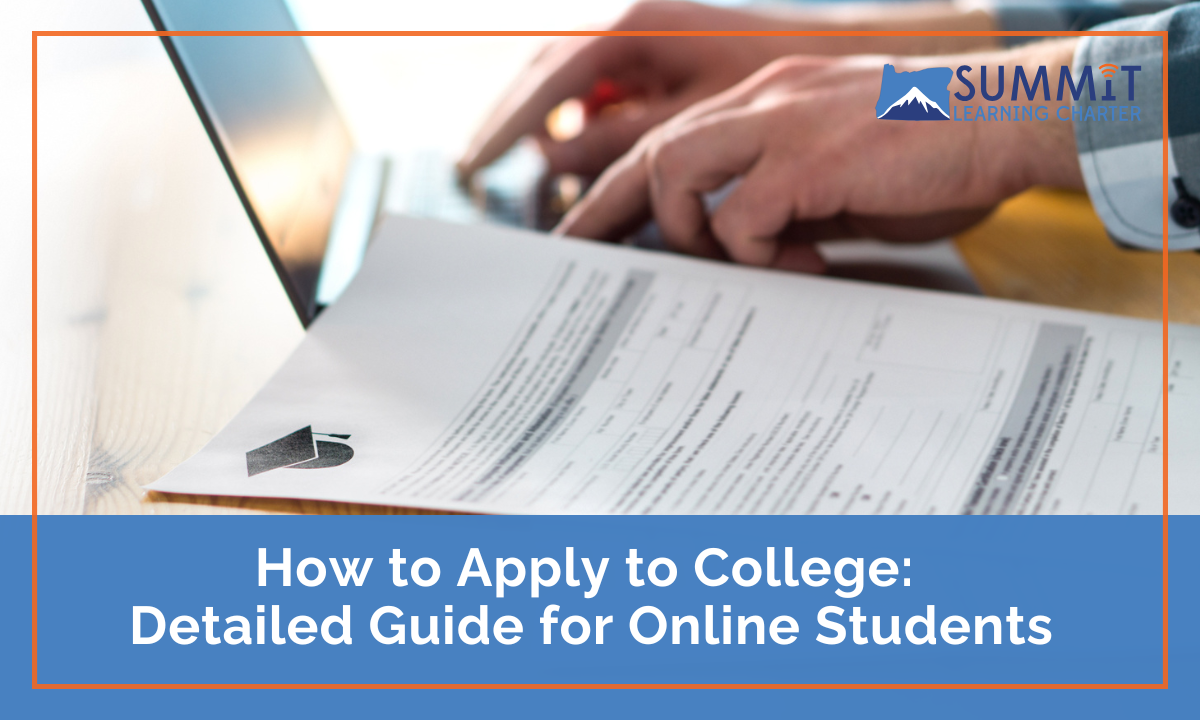
How to Apply to College | Detailed Guide for Online Students
Applying for college is a big deal!
At this stage in your life, deciding where to apply and what you want to major in, are probably among the most important decisions you’ve ever had to make. So it’s normal to feel overwhelmed with the whole process – especially if you study online.
As an online student, you may not have the same in-person resources as traditional students, but you also have some advantages, for example, virtual learning can better prepare you for remote work. And don’t worry, applying for college won’t be any different for you as an online student. Whether you’re juggling extracurriculars, volunteer work, or your studies, we’ve got you covered.
In this step-by-step guide, we’ll break down the entire process of applying for college as an online student to help you navigate everything from transcripts to personal statements.
Start Early and Plan Ahead

Before we get into the steps of applying for college, one of the most important tips we can give you is to start early. Timing is everything when it comes to applying for college and you want to make sure you have plenty of time to get your documents and transcripts in order.
Start researching schools at least a year before your intended start date. Pay close attention to application due dates since they can vary depending on whether you’re applying for early decision, early action, or a regular decision.
It’s also a good idea to create an application calendar to track important dates – things like application and financial form due dates, and SAT/ACT test dates. For virtual students applying to college, this added layer of organization can be really helpful.
How to Apply to College for Online Students
An easy way to approach the college application process is to take it in steps. Here are 8 steps to follow to apply to college.
1. Research Colleges That Fit Your Goals and Needs
Before you can apply to colleges, you need to know which ones you want to apply to.
Start by listing schools that align with your academic interests, career goals, and personal preferences. Make sure to consider both four-year universities and community colleges, as the application processes might differ.
Here are some questions to ask yourself when researching colleges:
- Do I want to commute to school or live on campus?
- Do I want to attend a college with a large campus or a smaller, more intimate setting?
- Which schools offer programs tailored to my interests?
- Do I want to study at a school that is online friendly?
Make sure to also include backup schools, or safety schools, on your list. A backup school is a college or university where your chances of acceptance are very high because your qualifications (like GPA and test scores) exceed their typical admissions criteria. Including these schools on your college list ensures you have solid options if your top-choice schools don’t work out.
2. Understand the Costs of Applications
Applying to college isn’t free. College application fees typically range from $50 to $90 per school, so be sure to prepare for those costs based on the number of colleges you’re planning to apply to. Reach out to a college’s admissions office if you’re unsure what their application fee is.
If you don’t think you’ll be able to pay application fees, reach out to the colleges you want to apply to. Many institutions will waive fees for students who demonstrate financial need. Be sure to check each school’s policy on financial aid.
3. Get Your Paperwork in Order
You’ll need to gather some documents and paperwork when applying for colleges. These can include things like a list of any volunteering activities you do, extracurriculars, or proof of honors. The most important documents, however, are your transcripts.
Reach out to your online school or virtual academy well in advance to request your official transcripts. It’s also a good idea to check if you can send your transcripts electronically directly to colleges to make the application process faster and easier.
When you should submit your transcript will depend on the college. Many colleges require a mid-year transcript and a final transcript after being accepted. Check with the colleges you’re applying to, to see when you need to submit your transcripts.
4. Take (or Retake) the SAT or ACT
Although some schools have moved to test-optional policies, many colleges still require SAT or ACT scores. These scores heavily impact scholarship opportunities, so performing well can open doors to additional financial aid. Schedule your test early enough to allow time for a retake if needed.
Since you manage your own schedule as an online student, you can tailor your test prep to your strengths and availability. Online practice tools like Khan Academy are great resources.
5. Request Letters of Recommendation
Letters of recommendation are an opportunity to showcase your character and achievements through the eyes of others. Reach out to teachers, counselors, or mentors who know you well.
Aim to ask for letters of recommendation at least two months before your application deadline. Provide your recommenders with all the necessary details, like submission deadlines and specific guidelines.
Anyone who writes you a letter of recommendation is doing you a favor, so when someone does, make sure to follow up with a thank-you note to show your appreciation!
6. Write a Standout Personal Statement

Your personal statement is your chance to shine. Use it to tell your story, highlight your accomplishments, and explain why you’re a great fit for the school.
Begin brainstorming ideas a few months before your first due date. Draft, edit, and refine your essay until it feels authentic and polished. You probably also want to get more than one set of eyes on your personal statement. Ask your parents, teachers, and mentors to read your statement and help you edit it. Online writing centers and peer review platforms are also excellent resources.
7. Apply for Financial Aid
Depending on your circumstances, you should consider applying for financial aid. Financial aid can help cover the costs of tuition fees or living expenses if you or your family cannot afford them. Even middle-income families can qualify for aid, so completing the Free Application for Federal Student Aid (FAFSA) is a smart step during your college application.
Financial aid applications typically open on October 1 for the following academic year and it’s best to complete the application as soon as possible.
In addition, you may want to look into scholarships, grants, and work-study opportunities. Many colleges also offer merit-based aid for high-achieving students – all of which can help significantly reduce expenses and make college more accessible.
8. Fill Out and Submit Your Applications
Once you have everything ready, it’s time to fill out applications. Make sure to give yourself plenty of time to fill out applications so you’re not scrambling to submit them on time. Fill them out early and review them thoroughly before submitting them.
As a general rule of thumb, it’s a good idea to apply to 5 to 8 colleges. Being accepted into a college will depend on your grades and performance, but by applying to multiple schools you can make sure you’ll be accepted into at least one.
After submitting your applications, the waiting game begins. Many schools have online portals where you can track your application status and make sure you submitted all the necessary paperwork. For fall admissions, you can typically expect to hear back by mid-March to April.
Avoid Common Applications Mistakes
Applying to college is a relatively easy process, so you don’t want to miss out on an acceptance letter because of an avoidable mistake. Here are some common mistakes to watch out for during the application process:
- Procrastination: Don’t leave anything to the last minute. Get started as soon as possible and submit your applications before the due dates.
- Typos: This may seem obvious, but it’s always worth mentioning. Always proofread your personal statements and application forms, run them through a spell checker, and if possible, ask someone else to look over them.
- Missing Deadlines: Use your application calendar to stay on track and make sure you don’t miss any important dates.
Get A Headstart on College

As an online student, applying to college might feel a little daunting, but if you follow our college application tips and steps, you’ll be well prepared. Remember that the key to success is staying organized and starting early.
Best of luck with your college applications, and if you still need some help, make sure to check out our list of 6 college prep resources or contact us with any questions.



